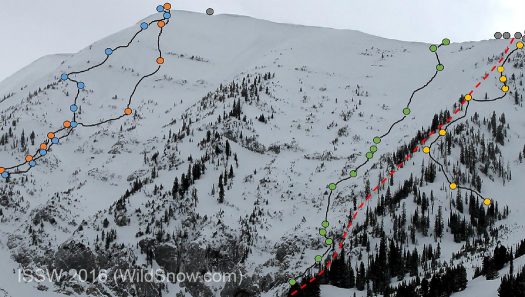It was a toss up between this presentation by Diana Saly being the coolest thing at ISSW, or Sarah Carpenter and Emmery Rheam’s presentations on teenage avy education.
The embedded video above is unfortunately a truncated version of what Diana is working with (and has been published elsewhere on the web for some time). In her full version presented at ISSW, she has numerous skier routes traced by lines as the time lapse follows them. Moreover, she does a more extensive job of showing the skiers working around the avalanche, both before and after the fact. (Once this proceeding is published on ISSW site, I’ll link.)

Still from Diana’s presentation, her caption: The first four skier tracks of S1 (green) S2 (blue) S3 (red) and S4 (yellow). S1 and S2 act as a group, S3 and S4 ski the slope simultaneously following very different lines.
What stood out to me is how “sidecountry” skiing is so dependent on that nearby ski resort boundary. Evidenced by once the skiers noted the avalanche, their convenient “stage left” exit back to the safety of controlled slopes and perhaps a warm cup of cocoa at the base lodge.
They do say that when planning your ski routes, have an exit plan. Only in North American ski touring I usually assume that’s moderate backcountry terrain — rather than a nearby resort! But whatever works.
In a broader sense, what’s interesting about this sort of thing is how avalanche researchers are focusing ever more on human behavior. Remember the days when “avalanche study” meant nothing more than snow science, with perhaps a short tale or two about how “the victim, at 18:00 hours, was entrained?”
Clearly no more. Counting all the oral presentations at ISSW, about 28 out of 70 presentations could said to have covered some aspect of human factors. That’s significant. It means the safety of recreation in avalanche terrain is on the radar more than ever. Yet more, it means ISSW is becoming more of something the non-scientist backcountry skier might find worth the money, time and travel to attend. (ISSW 2017 will be in Innsbruck, Austria.)
As for Diane and her time lapse camera, here’s hoping she’s running it this winter as well and will present a sequel. I’ll propose a more catchy title: “Bridger Bowl Football Skiing, End Zone or the Sidelines?”
Condensed version of her abstract intro:
USING TIME-LAPSE PHOTOGRAPHY TO MONITOR AVALANCHE TERRAIN
Diana Saly, Jordy Hendrikx, Jerry Johnson, Doug Richmond, Montana State University and Bridger Bowl Ski PatrolOn January 14, 2016 an avalanche occurred on the Football Field of Saddle Peak in Southwest Montana. Saddle Peak is a backcountry slope, located immediately adjacent to the Bridger Bowl Ski Area boundary… A time-lapse digital SLR… with a clear view of Saddle Peak captured the avalanche. Diana Saly (researcher) and Doug Richmond (Bridger Bowl Patrol Director) met …where Richmond was initiating and coordinating the response. The team reviewed the images and assessed skier involvement within minutes of the event. Two skiers were photographed in close proximity to the avalanche during release and resulting avalanche. Both skiers were photographed returning to the ski area boundary following the avalanche and confirmed as not involved… The data…provides an opportunity to document terrain use in different snowpack and avalanche conditions by travelers in easily accessed backcountry terrain.
WildSnow.com publisher emeritus and founder Lou (Louis Dawson) has a 50+ years career in climbing, backcountry skiing and ski mountaineering. He was the first person in history to ski down all 54 Colorado 14,000-foot peaks, has authored numerous books about about backcountry skiing, and has skied from the summit of Denali in Alaska, North America’s highest mountain.
